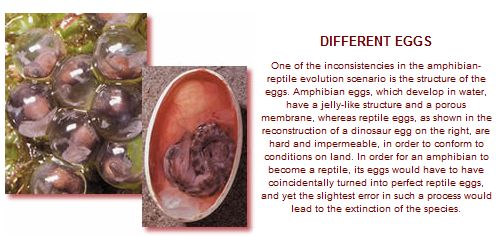Dinosaur, lizard, turtle, crocodile-all these fall under the class of reptiles. Some, such as dinosaurs, are extinct, but the majority of these species still live on the earth. Reptiles possess some distinctive features. For example, their bodies are covered with scales, and they are cold-blooded, meaning they are unable to regulate their body temperatures physiologically (which is why they expose their bodies to sunlight in order to warm up). Most of them reproduce by laying eggs.
Regarding the origin of these creatures, evolution is again at an impasse. Darwinism claims that reptiles evolved from amphibians. However, no discovery to verify such a claim has ever been made. On the contrary, comparisons between amphibians and reptiles reveal that there are huge physiological gaps between the two, and a "half reptile-half amphibian" would have no chance of survival.
One example of the physiological gaps between these two groups is the different structures of their eggs. Amphibians lay their eggs in water, and their eggs are jelly-like, with a transparent and permeable membrane. Such eggs possess an ideal structure for development in water. Reptiles, on the other hand, lay their eggs on land, and consequently their eggs are designed to survive there. The hard shell of the reptile egg, also known as an "amniotic egg," allows air in, but is impermeable to water. In this way, the water needed by the developing animal is kept inside the egg.
If amphibian eggs were laid on land, they would immediately dry out, killing the embryo. This cannot be explained in terms of evolution, which asserts that reptiles evolved gradually from amphibians. That is because, for life to have begun on land, the amphibian egg must have changed into an amniotic one within the lifespan of a single generation. How such a process could have occurred by means of natural selection and mutation-the mechanisms of evolution-is inexplicable. Biologist Michael Denton explains the details of the evolutionist impasse on this matter:
Every textbook of evolution asserts that reptiles evolved from amphibia but none explains how the major distinguishing adaptation of the reptiles, the amniotic egg, came about gradually as a result of a successive accumulation of small changes. The amniotic egg of the reptile is vastly more complex and utterly different to that of an amphibian. There are hardly two eggs in the whole animal kingdom which differ more fundamentally… The origin of the amniotic egg and the amphibian - reptile transition is just another of the major vertebrate divisions for which clearly worked out evolutionary schemes have never been provided. Trying to work out, for example, how the heart and aortic arches of an amphibian could have been gradually converted to the reptilian and mammalian condition raises absolutely horrendous problems.92
Nor does the fossil record provide any evidence to confirm the evolutionist hypothesis regarding the origin of reptiles.
Robert L. Carroll, an evolutionary paleontologist and authority on vertebrate paleontology, is obliged to accept this. He has written in his classic work, Vertebrate Paleontology and Evolution, that "The early amniotes are sufficiently distinct from all Paleozoic amphibians that their specific ancestry has not been established."93 In his newer book, Patterns and Processes of Vertebrate Evolution, published in 1997, he admits that "The origin of the modern amphibian orders, (and) the transition between early tetrapods" are "still poorly known" along with the origins of many other major groups.94
The same fact is also acknowledged by Stephen Jay Gould:
No fossil amphibian seems clearly ancestral to the lineage of fully terrestrial vertebrates (reptiles, birds, and mammals).95
So far, the most important animal put forward as the "ancestor of reptiles" has been Seymouria, a species of amphibian. However, the fact that Seymouria cannot be a transitional form was revealed by the discovery that reptiles existed on earth some 30 million years before Seymouria first appeared on it. The oldest Seymouria fossils are found in the Lower Permian layer, or 280 million years ago. Yet the oldest known reptile species, Hylonomus and Paleothyris, were found in lower Pennsylvanian layers, making them some 315-330 million years old.96 It is surely implausible, to say the least, that the "ancestor of reptiles" lived much later than the first reptiles.
In brief, contrary to the evolutionist claim that living being evolved gradually, scientific facts reveal that they appeared on earth suddenly and fully formed.
92 Michael Denton, Evolution: A Theory In Crisis, Adler and Adler, 1986, pp. 218-219.
93 Robert L. Carroll, Vertebrate Paleontology and Evolution, W. H. Freeman and Co., New York, 1988, p. 198.
94 Robert L. Carroll, Patterns and Processes of Vertebrate Evolution, Cambridge University Press, 1997, pp. 296-97.
95 Stephen Jay Gould, "Eight (or Fewer) Little Piggies," Natural History, vol. 100, no. 1, January 1991, p. 25.(emphasis added)
96 Duane Gish, Evolution: The Fossils Still Say No!, Institute For Creation Research, California, 1995, p. 97.
93 Robert L. Carroll, Vertebrate Paleontology and Evolution, W. H. Freeman and Co., New York, 1988, p. 198.
94 Robert L. Carroll, Patterns and Processes of Vertebrate Evolution, Cambridge University Press, 1997, pp. 296-97.
95 Stephen Jay Gould, "Eight (or Fewer) Little Piggies," Natural History, vol. 100, no. 1, January 1991, p. 25.(emphasis added)
96 Duane Gish, Evolution: The Fossils Still Say No!, Institute For Creation Research, California, 1995, p. 97.



No comments:
Post a Comment